Uphill Running Technique: How to Run Uphill (the Right Way)
Uphill running doesn't have to suck. Learn hill running tips & techniques to make running uphill a more pleasant part of your training.
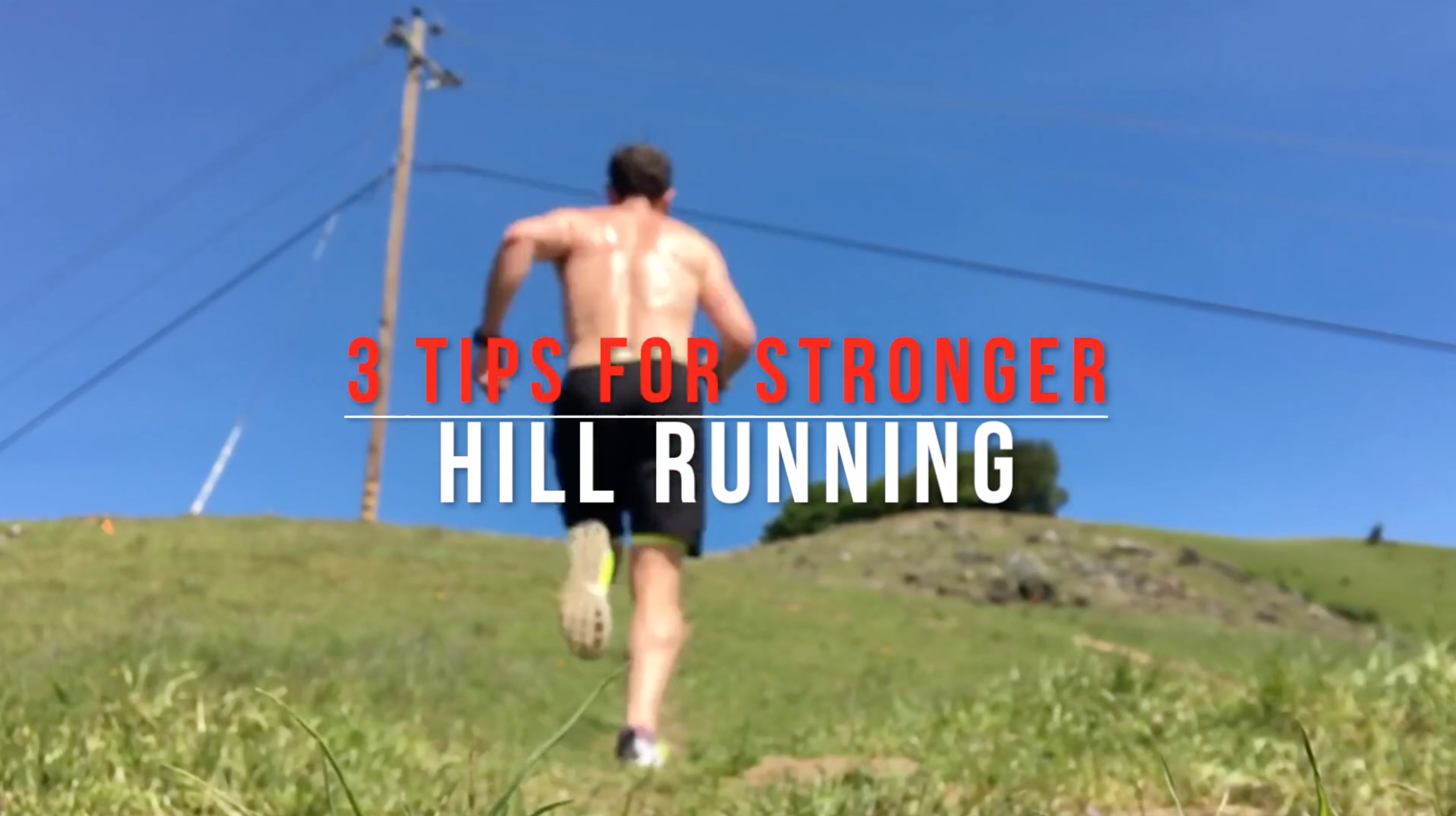
Uphill running can be an absolute joy—if you train right. While some runners love running hills more than others, none of us are strangers to them! Hills are incredibly useful tools in tackling running challenges, developing muscle strength, and learning how to run properly.
If you’re like most of the TRE coaches, it’s virtually impossible to get through a training run without uphill running a decent amount of the time!
Running uphill might feel like a slog right now, but we have some tips to transform your experience moving forward. Below, we’ll help you master uphill running technique and learn to love the incline.
The Benefits of Running Uphill
Hill running workouts are excellent for improving running posture and endurance, especially when we run them short and fast (also known as hill sprints). Here a just a few of the many benefits of hill running:
- Hill running is an excellent introduction to speed work. The reduced impact and freedom of movement we experience during uphill running act as stepping stones to pure speedwork down the road.
- Running uphill uses different muscle fibers than those recruited when running on flat surfaces. Our fast-twitch muscle fibers are called on to power us up steep hills, and training those specific muscle fibers helps us develop endurance as runners.
- Hill running teaches us how to run correctly by “fixing” many mechanical faults we see on flat ground, such as over-striding, over-rotation, sluggish cadence, excessive heel-striking, and more.
Read on for three quick hill running tips that can make running easier–and can help you become a stronger, more efficient runner!
How to Run Uphill: 3 Hill Running Tips
Uphill Running Tip #1: Stay Tall on the Hills
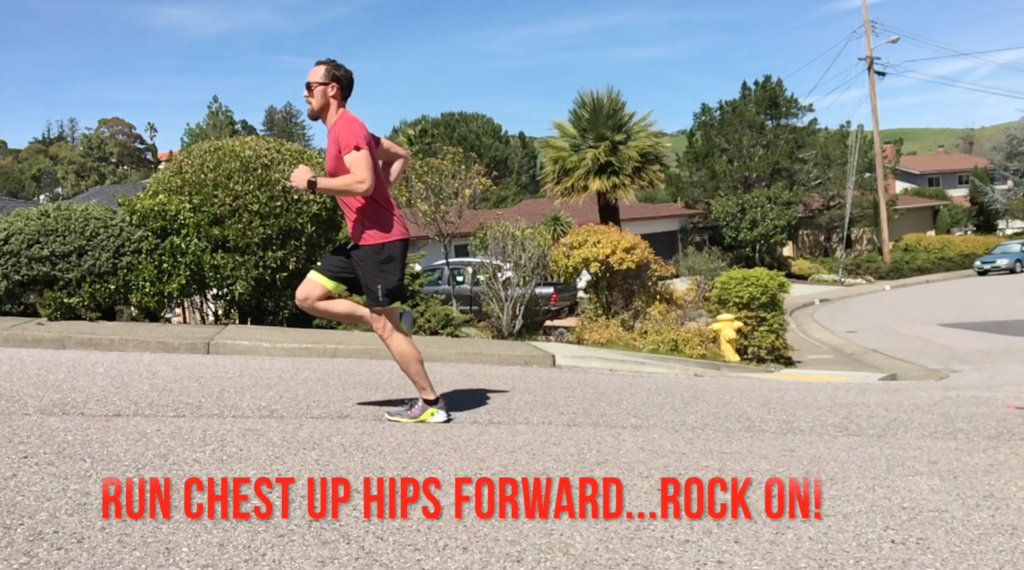
One significant tendency we see in hill running is poor posture, particularly in the hips.
As the slope of a hill steepens, so does our perception of leaning forward. We’re naturally inclined to deal with it by bending at the waist–as if reaching for something on the floor.
Bending over like this creates harmful, unnecessary stress on our lower backs. It also becomes more difficult for us to maintain full hip extension, robbing each stride of power and efficiency.
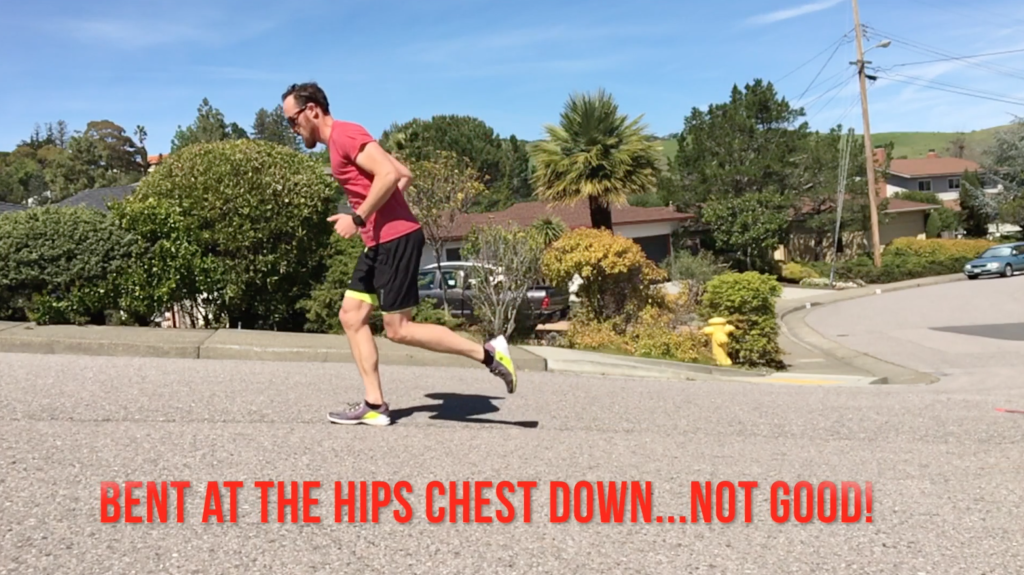
Now that you’re aware, let’s protect our lower backs and improve stride efficiency by practicing proper running form.
Of course, there’s an “incline limit” to our ability to stay tall when running up particularly steep hills. At a certain point, we can’t remain tall due to things like ankle range of motion, strength, and balance. That being said, staying as tall as possible always reaps tremendous advantages.
When running uphill, stay tall–just like we do on flat ground. I often say, “hips into the hill” to help runners focus on driving the hips forward and avoiding bending over at the hips. It takes a lot of focus, but practice makes perfect!
Training Drill: Tall Hill Repeats
Try this exercise out once a week during a training run to improve your overall running performance:
- Choose a “runnable” hill–one with no more than a 5º incline.
- Jog in place to start, establishing a tall running posture.
- Run up the hill for 30 seconds, constantly reminding yourself to drive your hips into the hill.
- Walk or jog back down to your starting point.
- Repeat four to five times and wrap up with a 10-minute walk or jog to cool down.
Tip #2: Set a Quick Cadence
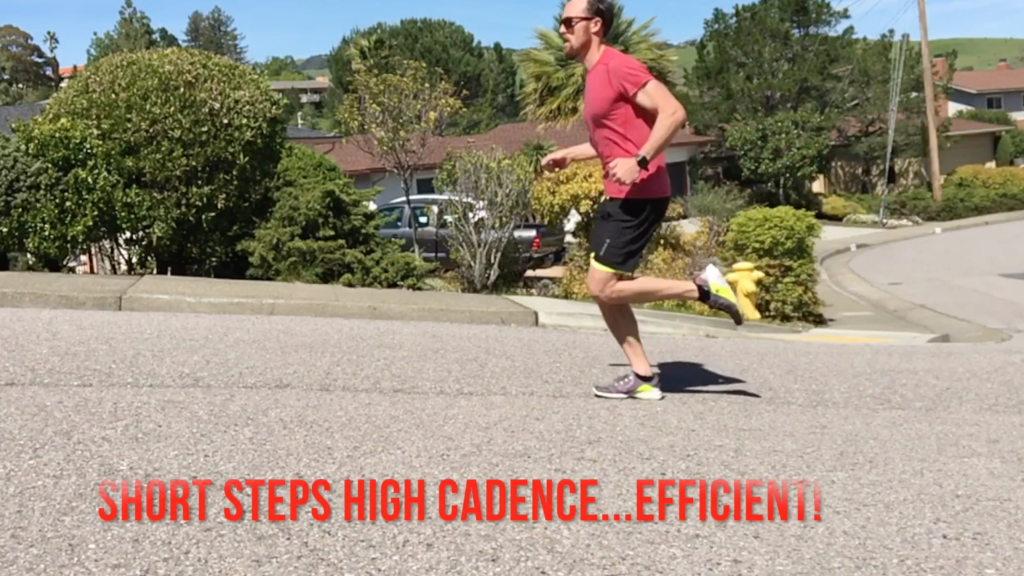
In general, we advise people to run with a cadence of around 90 steps per minute (spm). This helps repair many running form issues such as over-striding, a funky arm swing, over-rotating your torso, and more.
Side note: If you’re considerably taller or shorter than average, you might be a bit above or below 90spm. Furthermore, beginner runners shouldn’t worry about hitting the target the cadence target right off the bat. Give yourself time and practice to craft your cadence!

The main goal with optimal cadence during hill running is maintaining 90spm. Since our stride length decreases due to slower speeds when we run up hills, 90spm will feel considerably faster than running on even terrain. We have to willingly adopt a shorter stride while running uphill.
Test your stride cadence with this exercise. Over-stride your way up a moderate hill. Literally bound on up with the longest steps you can take! You won’t be able to do it for long because it’s overwhelmingly tiring.
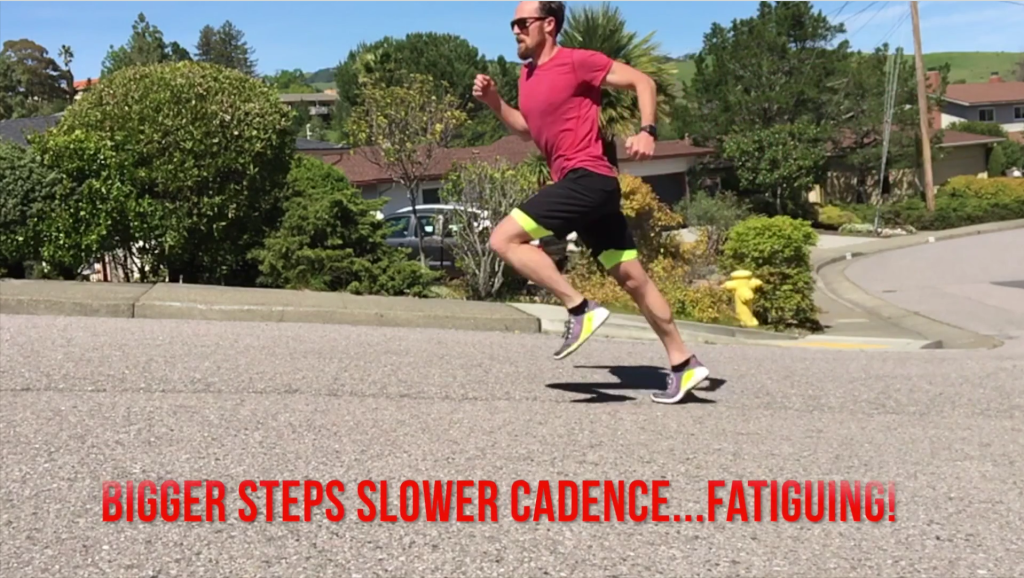
If we keep the cadence as high as we do on flat surfaces, we can maintain a more efficient rhythm not only for the hill sections, but for the entirety of the run.
Training Drill: Cadence Specific Hill Repeats
Put this hill workout into your running schedule to train yourself on how to maintain the right cadence in your stride:
- Find a “runnable” hill–one with no more than a 5º incline again.
- At the base of the hill, run in place at a cadence of 85-90spm for about 20-30 seconds.
- Run up the hill while maintaining your rhythm. Count your steps on one leg for 60 seconds–you should count about 85-90 steps.
- Walk or jog down to the base of the hill.
- Repeat four to five times, and finish up with a 10-minute walk or jog to cool down.
Pro tip: A metronome is a useful tool that helps you establish an optimal running cadence. Check out the MetroTimer app to use during your next run.
Tip #3: Relax Those Ankles
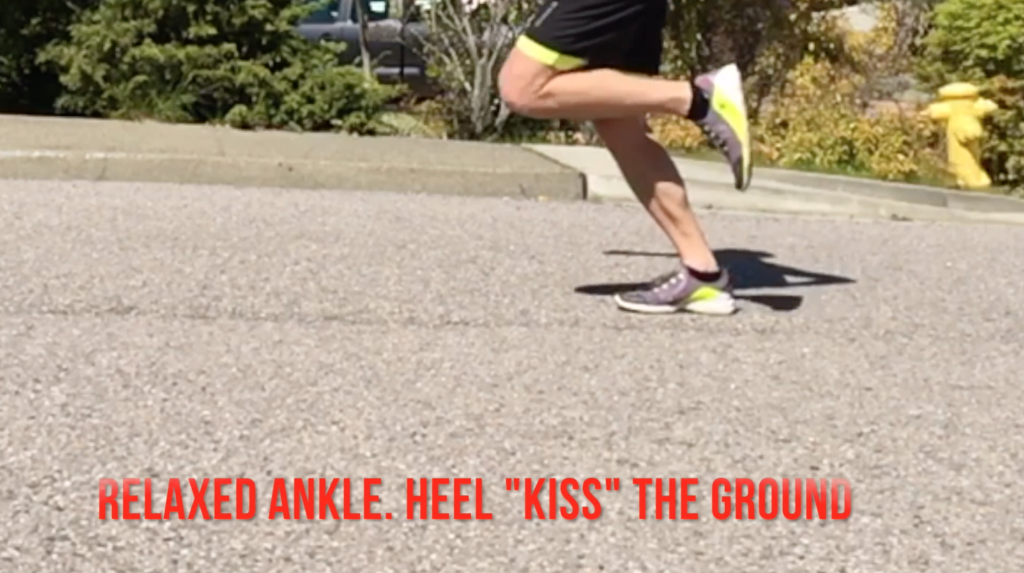
One thing that comes to mind when talking about hill running is lifted calves. While it’s not completely avoidable, we can definitely make improvements!
When running uphill, we generally need to employ a greater range of motion in our ankles than we do on flat ground. If we lack this range of motion–called dorsiflexion–we are forced to run on our toes.
Don’t believe me? Here’s a test–you’re standing while reading this, right? Push up onto your toes for the rest of the article. Which muscles are working hard to keep you up there? That’s right, you feel the burn in your calves. If you run like this consistently, you’ll end up with strained or injured calves–and might wake up in the middle of the night to painful “charlie horses!”
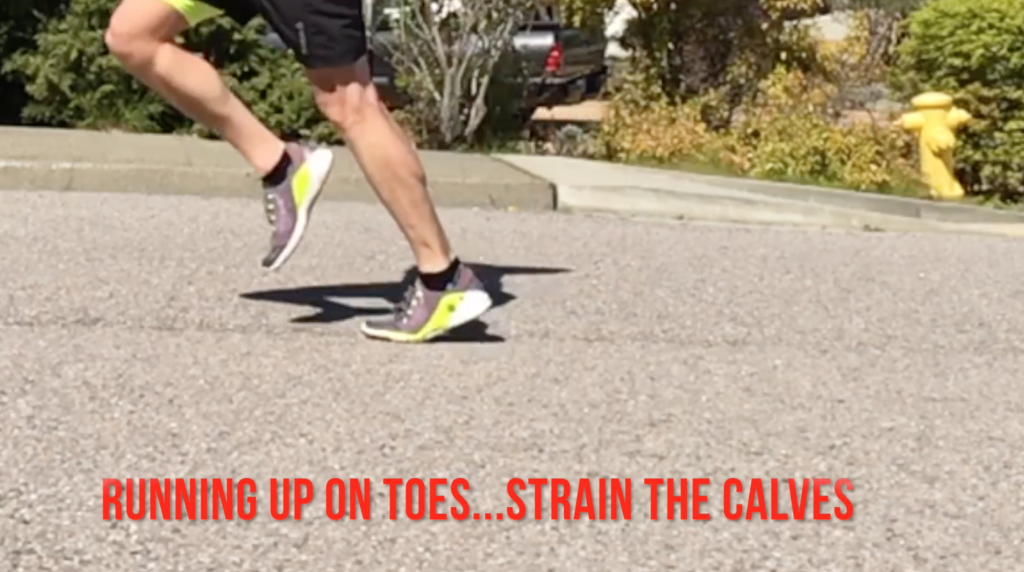
To reduce the strain on your calves, make sure your heels lightly kiss the ground with every step. The “heel-kiss” saves your calves in your stride and prevents the unpleasant calf meltdown catastrophe.
Worried about heel striking? As the hill gets steeper, the likelihood of overstriding and heel striking will lessen. Go ahead, try it out.
Of course, there’s a spectrum of relaxation. We shouldn’t feel loosey-goosey in our ankles. However, allow a bit more slack in your ankles–your lower legs will thank you! Remember: We are aiming for a slight heel kiss.
Training Drill: The Heel Kiss
Incorporate this drill into your running plan to practice staying off your toes and protecting your calves.
- Find a “runnable” hill–one with no more than a 5º incline.
- Run up the hill four to five times for 60 seconds each, allowing your heel to lightly kiss the ground with every step.
- Complete your workout with a 10-minute walk or jog to cool down.
Note: If you have stiff ankles, this drill may be difficult. However, that signals a red flag that your ankles need some mobility work.
Tip #4: Power Up Those Arms
We often forget about our arms when we're huffing and puffing up a hill, but they're secret weapons for uphill running. Here's why:
Use a compact arm swing — Keep your elbows bent at about 90 degrees and swing your arms from your shoulders, not your elbows. This helps maintain your rhythm and propels you forward more efficiently.
Match your arm speed to your leg turnover — As you increase your cadence on the hills, make sure your arms are keeping pace. This synchronization helps maintain your balance and momentum.
Drive those elbows back — Imagine you're trying to elbow someone behind you. This backward motion helps counterbalance your forward lean and gives you a little extra oomph with each stride.
Remember, your arms aren't just along for the ride — they're an integral part of your uphill running form. So pump those arms and watch yourself power up those inclines!
Tip #5: Master the Mental Game
Let's face it — hills can be intimidating. But half the battle is in your head. Here's how to tackle the mental aspect of uphill running:
Break it down — Instead of fixating on the entire hill, focus on getting to the next lamppost or tree. These small victories add up and before you know it, you'll be at the top.
Use positive self-talk — Replace "This hill is killing me" with "I'm getting stronger with every step." It might sound cheesy, but it works!
Embrace the challenge — Try to reframe hills as opportunities rather than obstacles. Each hill is a chance to become a better, stronger runner.
Your mind is a powerful tool. Train it just like you train your body, and you'll find those hills becoming less daunting with each run.
Tip #6: Practice Downhill Running Too
We talk a lot about running uphill, but what goes up must come down. Mastering downhill running is crucial for becoming a well-rounded hill runner. Here's why it matters:
Build eccentric strength — Downhill running strengthens your quads eccentrically, which can help prevent muscle damage during long runs or races.
Improve your overall speed — Learning to run downhill efficiently can shave seconds (or even minutes) off your race times.
Enhance your balance and coordination — Navigating steep descents improves your proprioception and agility, making you a more well-rounded runner.
When running downhill, lean slightly forward from your ankles (not your waist), keep your steps light and quick, and try to land midfoot rather than on your heels.
Embrace the Ups With These Hill Running Tips
Running uphill doesn’t have to suck. With these hill running tips, you can learn to master it—and look forward to it.
Ease into it a little bit at a time. Don’t set out to sprint up a mountain this weekend. Instead, find a nice gradual hill to start incorporating these hill running tips. Once you’re comfortable with that, find a bit steeper of a hill.
Master uphill running technique is relatively simple, but it takes time to adapt and build all the muscles you need for sustained training and performance. Give your body time to grow stronger.
Are you ready to get the most out of every run? Check out The Daily Run App designed for runners of every level. You’ll discover the robust toolkit full of run programs, strength exercises, mobility activities, running techniques, and more!
